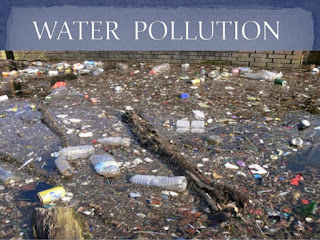Health Implications Of Environmental Mercury Pollution
Mercury is ranked as one of the most toxic elements or substances in the world, coming just behind arsenic and lead as third. This environmental pollutant continues to be dumped into our waterways and soil, is being spilled into our atmosphere, and continually contaminates our food and water. Although mercury pollution was initially minimal, human activities have nearly tripled the amount of mercury in the environment and the atmospheric burden is increasing 1.5 percent per year. Environmental mercury, either through soil or water pollution, can enter the food chain through plant and livestock. Once in the food chain mercury can bioaccumulate causing harmful effects to human health.
Whether it exists in its elemental form, inorganic mercury or as organic mercury, the
sources of environmental pollution of mercury are abundant. Current sources of human exposure include:
1. Elemental
mercury: Sources of mercury pollution in this form include dental amalgam, thermometers, barometers, fossil
fuel emissions, incandescent lights, batteries, ritualistic practices using
mercury, and the incineration of medical waste. Toxic vapors in the environment from mercury vaporization or the burning of
mercury containing materials can adversely
affect human health when they enter the respiratory system and pass readily
into the circulation. Due to
its lipophilic nature, mercury vapor can accumulate in the kidney, liver, and especially the brain. It is
estimated that the half-life of mercury in the brain can be as long as 20 year.
2. Organic
mercury: Environmental pollution sources include exposure to fossil fuel emissions, the incineration of
medical waste, dental amalgam, and various commercial products including skin
creams, germicidal soaps, various medications, teething powders, analgesics,
diaper treatments, vaccinations, thermometers, sphygmomanometer, barometers,
incandescent lights, and batteries. Among the most dangerous mercury compound
is dimethyl mercury. This environmental pollutant is toxic enough to cause death if only a few
microliters is spilled on the skin, or even latex gloves. Mercury poisoning can
result in death, mental retardation, dysarthria, blindness, neurological
deficits, loss of hearing, developmental defects, and abnormal muscle tone.
Research studies show that toxic vapors formed from environmental pollution of mercury or the burning of mercury
containing materials can enter th erespiratory system and pass readily into the
circulation. Mercury
accumulation in the heart is thought to contribute to cardiomyopathy. Studies
show that mercury levels in the heart tissue of individuals
who died from idiopathic dilated cardiomyopathy were found to be on average 22
000 times higher than in individuals who died of other forms of heart disease
Mercury poisoning may be
responsible for chest pains, especially in individuals under age 45.
When this toxic pollutant is present in food, it is
absorbed when ingested. This can cause various digestive disturbances as it can
inhibit the production of some digestive enzymes. The health effects of mercury on the gastrointestinal system
typically presents as abdominal pain, indigestion, inflammatory bowel
disease, ulcers and bloody diarrhea. Mercury ingestion has also been associated
with the destruction of intestinal flora which can increase the amount of
undigested food products in the blood stream causing immune mediated reactions
and reduced resistance to pathogenic infection.
Environmental pollution from mercury
has serious human health implications because of its effect on the nervous
system. The most devastating effect of mercury in the nervous system
is its interference with the production of energy which can impair
cellular detoxification processes causing the cell to either die or live in a
state of chronic malnutrition.
This toxic chemical can damage the
blood-brain barrier which
allows the penetration of the brain
by other toxic metals and pollutants. The health effects of mercury poisoning in the central nervous system includes depression, paranoia, extreme irritability, hallucinations,
an inability to concentrate, memory loss, tremors of the hands, head, lips,
tongue, jaw and eyelids, weight loss, perpetually low body temperature,
drowsiness, headaches, insomnia, and fatigue. Autism is a syndrome
characterized by impairments in social relatedness, language and communication,
a need for routine and sameness, abnormal movements, and sensory dysfunction.
Mercury has
been shown to cause behavioral
dysfunctions similar to traits defining or associated with autism leading some
to suggest that many cases of autism may be a form of mercury poisoning.
Mercury
affects hormone activities in the body. The
thyroid is one of the largest endocrine glands in the body which controls how quickly the body burns energy, makes proteins, and
how sensitive the body should be to other hormones. The thyroid displays an affinity for accumulating mercury which in turn blocks thyroid hormone production by inhibiting or altering
hormone action leading to the impairment of body temperature control,
hypothyroidism, thyroid inflammation and depression. Also, the
pancreas is
affected by the toxic effects of
mercury pollution
in the body. Insulin, the molecule
involved in diabetes, readily
binds to mercury causing it to
interfere with normal biological function and blood glucose levels.
Recent
studies in Hong Kong have linked increased mercury pollution to infertility
in both men and women. The human health effect of this in males includes
low sperm count, and testicular weight. Evidence also links toxic mercury with erectile dysfunction. In females, environmental pollution from this
toxic chemical has
been shown to affect estrogen and progesterone levels leading to
ovarian dysfunction, painful or irregular menstruation, premature menopause,
and tipped uterus. Studies have shown the relationship between mercury pollution
and menstrual
disorders including abnormal bleeding, short, long, irregular cycles, and
painful periods.
In relation to its effect on the reproductive system, mercury pollution
has been associated with the fetotoxicity which may occur in form of miscarriage, spontaneous abortions, stillbirth, and low birth
weights. Exposure to environmental
pollution by mercury during pregnancy has
been linked to neural tube defects and delayed growth in newborns. Mercury can cross the placenta where it can inhibit fetal
brain development leading
to cerebral palsy and psychomotor retardation in the
latter stages of development.






Comments
Post a Comment